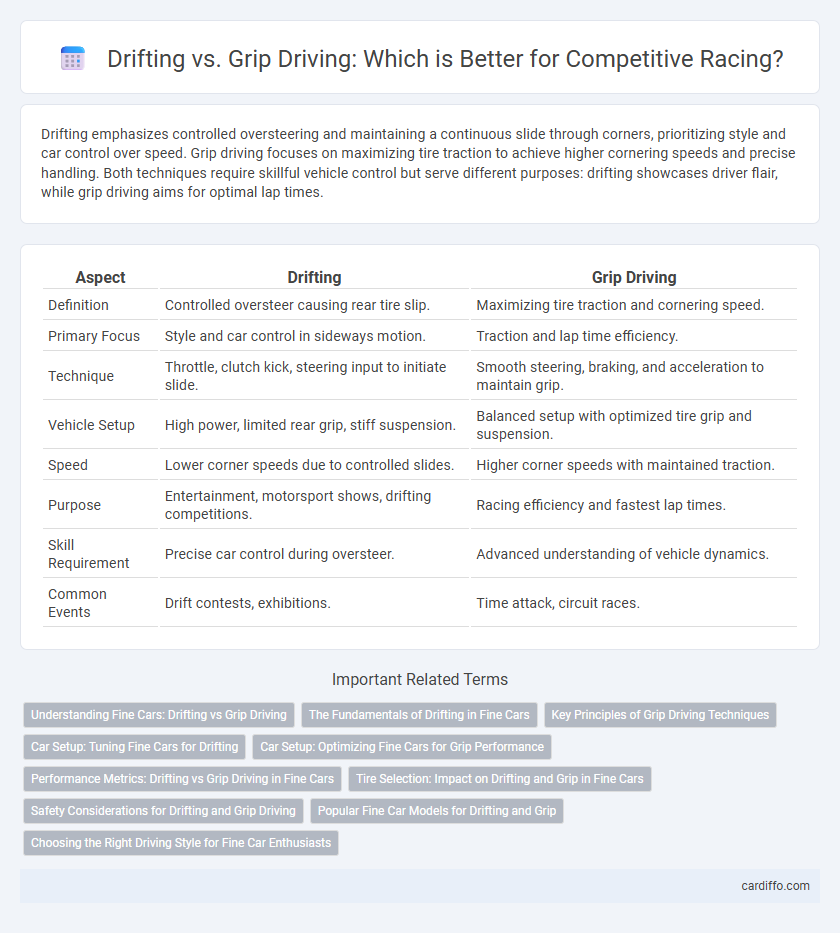Drifting emphasizes controlled oversteering and maintaining a continuous slide through corners, prioritizing style and car control over speed. Grip driving focuses on maximizing tire traction to achieve higher cornering speeds and precise handling. Both techniques require skillful vehicle control but serve different purposes: drifting showcases driver flair, while grip driving aims for optimal lap times.
Table of Comparison
| Aspect | Drifting | Grip Driving |
|---|---|---|
| Definition | Controlled oversteer causing rear tire slip. | Maximizing tire traction and cornering speed. |
| Primary Focus | Style and car control in sideways motion. | Traction and lap time efficiency. |
| Technique | Throttle, clutch kick, steering input to initiate slide. | Smooth steering, braking, and acceleration to maintain grip. |
| Vehicle Setup | High power, limited rear grip, stiff suspension. | Balanced setup with optimized tire grip and suspension. |
| Speed | Lower corner speeds due to controlled slides. | Higher corner speeds with maintained traction. |
| Purpose | Entertainment, motorsport shows, drifting competitions. | Racing efficiency and fastest lap times. |
| Skill Requirement | Precise car control during oversteer. | Advanced understanding of vehicle dynamics. |
| Common Events | Drift contests, exhibitions. | Time attack, circuit races. |
Understanding Fine Cars: Drifting vs Grip Driving
Fine cars designed for drifting feature reinforced chassis and adjustable suspensions to maximize controlled oversteer and tire slip, enhancing cornering excitement. In contrast, grip driving cars emphasize high-performance tires, stiffer suspension setups, and aerodynamic components to maintain maximum traction and stability through precise cornering. Understanding these distinct mechanical and setup differences allows drivers to optimize vehicle dynamics for either drifting's controlled slides or grip driving's high-speed precision.
The Fundamentals of Drifting in Fine Cars
Drifting in fine cars centers on controlled oversteer, where the driver intentionally breaks traction in the rear wheels while maintaining steering control through countersteering techniques. High-performance suspension setups, precise throttle modulation, and weight transfer dynamics are critical to executing smooth, sustained drifts. Unlike grip driving, which prioritizes maximum tire adhesion and cornering speed, drifting emphasizes style, vehicle balance, and continuous car angle management throughout a turn.
Key Principles of Grip Driving Techniques
Grip driving techniques emphasize maintaining optimal tire traction through precise steering, throttle control, and braking. Key principles include smooth inputs to maximize tire contact patch, balanced weight transfer to enhance grip during cornering, and progressive acceleration to avoid wheel spin. Understanding and applying these fundamentals allows drivers to maintain superior control and faster lap times on the track.
Car Setup: Tuning Fine Cars for Drifting
Fine-tuning cars for drifting requires adjusting suspension settings to achieve optimal rear-wheel slip and control by softening rear shocks and stiffening front suspension for better weight transfer. Tire selection favors wider, lower-pressure rear tires to increase grip and induce controlled slides, while the steering angle is often extended to enhance maneuverability during drifts. Engine tuning focuses on delivering smooth, continuous power with quick throttle response to maintain consistent rear wheel spin essential for sustained drifting performance.
Car Setup: Optimizing Fine Cars for Grip Performance
Fine car setup for grip driving involves optimizing suspension stiffness, tire pressure, and alignment to maximize traction and stability during high-speed cornering. Adjusting camber angles and stiffening anti-roll bars enhances tire contact with the road, reducing body roll and improving grip. Proper fine-tuning of differential settings ensures efficient power delivery to the wheels, further boosting grip performance in precision driving scenarios.
Performance Metrics: Drifting vs Grip Driving in Fine Cars
Drifting prioritizes controlled oversteer, emphasizing style and car angle with lower lap times but higher tire wear and variable traction. Grip driving focuses on maximizing tire contact and minimizing slip angle, achieving faster lap times and consistent cornering stability in fine cars. Performance metrics highlight grip driving's superior lap times and efficiency, while drifting scores higher on driver skill expression and visual appeal.
Tire Selection: Impact on Drifting and Grip in Fine Cars
Tire selection plays a crucial role in both drifting and grip driving, directly affecting vehicle performance and control. For drifting, tires with softer compounds and lower grip levels encourage controlled slides and easier breakaway, while grip driving requires harder compound tires that provide maximum traction and cornering stability. Choosing the appropriate tire depends on driving style, with high-performance racing tires enhancing grip and specialized drifting tires optimizing slide duration and precision.
Safety Considerations for Drifting and Grip Driving
Drifting involves controlled oversteering, which increases the risk of vehicle instability and requires advanced skill to maintain safety during high lateral forces. Grip driving prioritizes tire traction and stability, reducing the likelihood of loss of control and making it generally safer for everyday and competitive driving. Proper safety gear, vehicle maintenance, and track conditions are critical to minimizing accidents in both drifting and grip driving disciplines.
Popular Fine Car Models for Drifting and Grip
The Nissan Silvia S15 and Toyota AE86 remain iconic choices for drifting due to their lightweight chassis and rear-wheel-drive layout, offering exceptional control and style on the track. For grip driving, the Subaru WRX STI and Ford Mustang GT are popular fine models, delivering superior traction and power with advanced suspension setups optimized for high-performance cornering. These vehicles exemplify the distinct engineering priorities in drifting versus grip driving disciplines, catering to enthusiasts seeking precision and thrill.
Choosing the Right Driving Style for Fine Car Enthusiasts
Drifting emphasizes controlled oversteer and dramatic car slides, appealing to enthusiasts who prioritize style and spectacle, while grip driving focuses on maximizing tire traction for precise cornering and faster lap times, favored by those who value performance and consistency. Selecting the right driving style depends on individual goals, vehicle setup, and track conditions, where drift cars often require modifications like limited-slip differentials and suspension tuning, while grip cars benefit from stiff suspension and high-grip tires. Fine car enthusiasts should evaluate their driving preferences and technical skills to decide between the artistic challenge of drifting and the technical precision of grip driving.
Drifting vs Grip Driving Infographic

 cardiffo.com
cardiffo.com